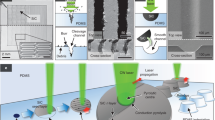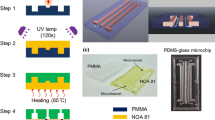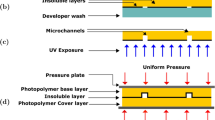Abstract
We report here positive and negative photosensitive polydimethylsiloxanes allowing direct micropatterning on wafer scale. One is a negative photodefinable polydimethylsiloxane (N-photoPDMS) which is covalently bonded on silicon dioxide surfaces, reaching a limit resolution of 20 μm. The other is an improvement to positive photodefinable polydimethylsiloxane (P-photoPDMS), reaching a limit resolution of 60 μm. These two novel methods present advantages compared to classical microfabrication methods as they are low cost and are conceived for rapid prototyping on wafer scale. Hence, to show that photoPDMS-based techniques can be applied to the fabrication of complex microfluidic devices used in MEMS or lab-on-chips, 192 N-photoPDMS-based microchannels (20 μm width) are placed on interdigitated nanoelectrodes (46 nm width) devices (IND), on wafer scale. We present the mechanical properties after crosslinking of N-photoPDMS. We also perform some pressure tests in one microfluidic device to demonstrate the robustness of the photoPDMS-based methodologies.









Similar content being viewed by others
References
Bhagat AAS, Jothimuthu P, Papautsky I (2007) Photodefinable polydimethylsiloxane (PDMS) for rapid lab-on-a-chip prototyping. Lab Chip 7:1192–1197
Brunner C, Ernst KH, Hess H, Vogel V (2004) Lifetime of biomolecules in polymer-based hybrid nanodevices. Nanotechnology 15:S5406–S5548
Chen J, Vaino AR, Smith RL, Collins SC (2008) Photomediated crosslinking of cinnamated PDMS for in situ direct photopatterning. J Polym Sci A 46:3482–3487
Choi KM, Rogers JA (2003) A photocurable poly(dimethylsiloxane) chemistry designed for soft lithographic molding and printing in the nanometer regime. J Am Chem Soc 125:4060–4061
Collin D, Martinoty P (2003) Dynamic macroscopic heterogeneities in a flexible linear polymer melt. Physica A 320:235–248
Collin D, Auernhammer G, Gavat O, Martinoty P, Brand H (2003) Frozen-in magnetic order in uniaxial magnetic gels: preparation and physical properties. Macromol Rapid Commun 24:737–741
Cong H, Pan T (2008) Photopatternable conductive PDMS materials microfabrication. Adv Funct Mater 18:1912–1921
Dittrich PS, Manz A (2006) Lab-on-a-chip: microfluidics in drug discovery. Nat Rev Drug Discov 5:210–218
Dou YH, Bao N, Xu JJ, Meng F, Chen HY (2004) Separation of proteins on surface-modified poly(dimethylsiloxane) microfluidic devices. Electrophoresis 25(17):3024–3031
Dow C (2005) Patternable silicones for electronics. Product Data Sheet, Information Product for WL-5351 and WL-5150. http://www.dowcorning.com/applications/search
Duffy DC, Schueller OJA, Brittain ST, Whitesides GM (1999) Rapid prototyping of microfluidic switches in poly(dimethylsiloxane) and their actuation by electro-osmotic flow. J Micromech Microeng 9:211–217
Jothimuthu P, Carroll A, Bhagat AAS, Lin G, James ME, Papautsky I (2009) Photodefinable PDMS thin films for microfabrication applications. J Micromech Microeng 19:045024
Lötters JC, Olthuis W, Veltink PH, Bergveld P (1997) The mechanical properties of the rubber elastic polymer polydimethylsiloxane for sensor applications. J Micromech Microeng 7:145–147
Martínez Rivas A, Séverac C, Carcenac F, Saya D, Nicu L, Vieu C (2008) Abstract MNE conference
McDonald JC, Whitesides GM (2002) Poly(dimethylsiloxane) as a material for fabricating microfluidic devices. Acc Chem Res 35(7):491–499
Mitchell P (2001) Microfluidics-downsizing large-scale biology. Nat Biotechnol 19:717–721
Pouliquen L, Coqueret X (1996) Polysiloxanes with benzophenone side groups: factors affecting their efficiency as free radical polymerization photoinitiators. Macromol Chem Phys 197:4045–4060
Rogez D, Francius G, Finkelmann H, Martinoty P (2006) Shear mechanical anisotropy of side chain liquid-crystal elastomers: influence of sample preparation. Eur Phys J E 20:369–378
Shaikh KA, Ryu KS, Goluch ED et al (2005) A modular microfluidic architecture for integrated biochemical analysis. PNAS 102(28):9745–9750
Sia SK, Whitesides GM (2003) Microfluidic devices fabricated in poly(dimethylsiloxane) for biological studies. Electrophoresis 24:3563–3576
Suhard S, Fau P, Chaudret B, Sabo-Etienne S et al (2009) When energetic materials, PDMS-based elastomers, and microelectronic processes work together: fabrication of a disposable microactuator. Chem Mat 21:1069–1076
Sun F, Jiang SL (2007) Synthesis and characterization of photosensitive polysiloxane. Nucl Instrum Methods Phys Res B 254:125–130
Torbiéro B, Pourciel-Gouzy M, Humenyuk I, Doucet JB, Martinez A, Temple-Boyer P (2006) Mass patterning of polysiloxane layers using spin coating and photolithography techniquesm. Microelectron J 37(2):133–136
Tsougeni K, Tserepi A, Gogolides E (2007) Photosensitive poly(dimethylsiloxane) materials for microfluidic applications. Microelectron Eng 84:1104–1108
Tuomikoski S, Franssila S (2005) Free-standing SU-8 microfluidic chips by adhesive bonding and release etching. Sens Actuators A 120:408–415
Wang PI, Nalamasu O, Ghoshal R, Ghoshal R, Schaper CD, Li A, Lu TM (2008) Novel photocurable epoxy siloxane polymers for photolithography and imprint lithograpy applications. J Vac Sci Technol B 26(1):244–248
Wheeler AR, Throndset WR, Whelan RJ et al (2003) Microfluidic device for single-cell analysis. Anal Chem 75(14):3581–3586
Acknowledgement
The first author (AMR) wants to thank the National Council for Science and Technology of Mexico (CONACYT) for the financing of his Ph.D. grant. We also wish to thank the TEAM service (Techniques et ÉquipementsAppliqués à la Microélectronique) for access to clean room facilities at LAAS-CNRS, especially Pierre-François Calmon for the elaboration of the different chrome masks and Sylviane Sabo-Etienne from LCC-CNRS (Laboratoire de chimie et coordination) for helpful discussions and permitting the access to chemistry facility. This work has been financially supported in part by the French National Agency for Research (ANR).
Author information
Authors and Affiliations
Corresponding author
Rights and permissions
About this article
Cite this article
Martínez Rivas, A., Suhard, S., Mauzac, M. et al. Simplified and direct microchannels fabrication at wafer scale with negative and positive photopolymerizable polydimethylsiloxanes. Microfluid Nanofluid 9, 439–446 (2010). https://doi.org/10.1007/s10404-009-0560-0
Received:
Accepted:
Published:
Issue Date:
DOI: https://doi.org/10.1007/s10404-009-0560-0




